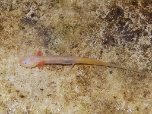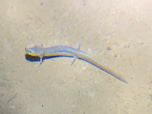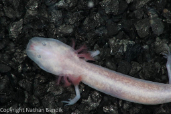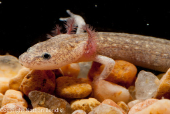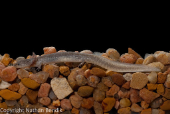Cascade Caverns Salamander (Eurycea latitans)
Description: The Cascade Caverns salamander is translucent, with a faint net-shaped pattern that is brown in color, often with white speckling. The species is rarely seen, so the amount of variation in their coloration is unknown. They are neotenic, meaning they retain characteristics into adulthood that are usually associated with juvenile salamanders, such as external gills. They have stout bodies, with short legs, and reduced eyes set under a layer of skin.
Habitat: Cascade caverns salamanders’ range into both underground cave and surface water stream. This species is typically found underneath small rocks, vegetation or leaf packets near flowing springs, or on the bare rock or silt bottoms of cave systems.
Range: Eurycea latitans are present in karstic springs and subterranean voids within the Trinity and Edwards aquifers in Central Texas, and are part of a complex of Eurycea found throughout aquifer systems in this area. Their distribution and genetic distinction is reliant upon groundwater connections both historically and currently. Due to the complexities of the hydrologic system, the genetic history of Eurycea, and the species' underground habitat, the exact distribution of this species of the Cascade Caverns salamander is not well defined, though they are understood to occupy karstic systems in and around Bexar and Kendall counties.
Found in these States:
TX
Diet: The salamanders are known to eat various insects including dragonflies, caddisflies, stoneflies, and small crustacea such as water scuds.
Reproduction: Little is known about the life history and reproduction of this species. Female Eurycea salamanders hatch eggs inside of their bodies after being fertilized by males. These aquatic salamanders do not develop substantially past the larval life stage and retain a fully developed set of gills throughout their lifespan.
Status: Listed as Vulnerable because its extent of occurrence (EOO) is 9,687 km2, it occurs in 10 or fewer threat-defined locations, and there is continuing decline in the extent and quality of its aquatic habitat in the Edwards Plateau region of central Texas, USA.
»» Kingdom: Animalia - Animals
»» Phylum: Chordata - Chordates
»» Subphylum: Vertebrata - Vertebrates
»» Class: Amphibia - (Amphibians)
»» Order: Caudata - Salamanders
»» Family: Plethodontidae - Lungless Salamanders
»» Genus: Eurycea
»» Species: Eurycea latitans - Cascade Caverns Salamander
This article uses material from the Wikipedia article "Cascade Caverns Salamander", which is released under the Creative Commons Attribution-Share-Alike License 3.0. Content may have been omitted from the original, but no content has been changed or extended.
|



